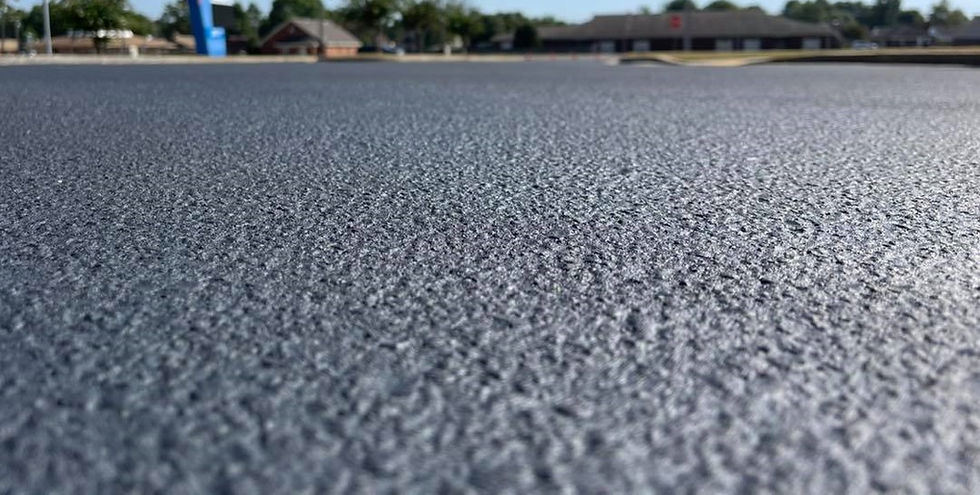The Risks of Sealcoating Over Concrete and Why You Should Avoid It
- Armor Asphalt

- Sep 25
- 3 min read
Sealcoating is often seen as a straightforward way to care for asphalt surfaces. However, applying the same concept to concrete can lead to significant issues. Many property owners may think sealcoating will enhance their concrete's look and durability, but this strategy can result in serious problems. In this article, we will explain why sealcoating concrete is a bad idea and suggest safer alternatives that better preserve the integrity of your surfaces.
Understanding Sealcoating
Sealcoating is a method used primarily on asphalt surfaces to protect them from damage caused by the sun, water, and harsh chemicals. It works by creating a barrier that prevents cracks and deterioration. Unlike asphalt, concrete has unique properties that make sealcoating a risky option.
Concrete is a porous material designed to allow moisture to escape. Asphalt, in contrast, is flexible and can expand or contract with temperature changes. When sealcoat is applied to concrete, it can trap moisture inside. This leads to issues that can severely compromise the concrete's strength and reliability.
The Dangers of Moisture Trapping
Moisture trapping is one of the main hazards associated with sealcoating concrete. When a sealcoat is applied, it creates a barrier that can keep water from evaporating. This trapped moisture leads to several damaging issues:
Spalling: Water can seep into the concrete and freeze, causing the surface to crack and flake. Studies show that almost 75% of all concrete spalling problems are due to inadequate moisture management. Sealcoating can worsen this issue as it prevents moisture from escaping.
Mold and Mildew Growth: The damp conditions from trapped water can foster mold and mildew growth. This not only harms the concrete but can also threaten the health of people nearby, with potential risks for respiratory issues.
Deterioration of the Concrete: Continuous moisture exposure can weaken concrete over time. A study indicated that improperly maintained concrete surfaces can lose up to 20% of their strength, leading to expensive repairs that could have been avoided.
Chemical Reactions
Another serious concern with sealcoating is the risk of chemical reactions. Many sealcoat products contain solvents that can react adversely with concrete. This can cause discoloration, damage, and even shorten the lifespan of the surface.
If the sealcoat is applied improperly, it can also create a slippery surface, presenting safety hazards especially in wet conditions. This is crucial for business owners and property managers, who have a responsibility to ensure a safe environment for customers and tenants alike.
Aesthetic Considerations
While sealcoating might provide a temporary cosmetic boost, the long-term consequences can be counterproductive. Problems like spalling and mold growth can significantly detract from the concrete's visual appeal. Unsightly cracks and discoloration can lead to a decline in property value.
Instead of opting for sealcoating, property owners can explore more effective ways to maintain their concrete's appearance. Regular cleaning, using concrete-specific sealers, and applying concrete stains or overlays are viable options that yield better outcomes.
Alternatives to Sealcoating
If you're looking to protect and beautify your concrete surfaces, consider these safer alternatives to sealcoating:
Concrete Sealers: These are specifically designed to penetrate the concrete surface without trapping moisture. Unlike sealcoating, concrete sealers can repel water and oils, allowing the concrete to breathe. Some high-quality sealers can reduce water absorption by over 95%, offering significant protection.
Concrete Stains: Stains enhance the natural color of concrete and provide a beautiful finish. They penetrate the surface, ensuring a long-lasting look without the risks associated with sealcoating. Unlike paint, stains don't peel away, making them a more durable option.
Overlays: If your concrete surface is showing signs of wear, a concrete overlay is an excellent choice. This process involves applying a thin layer of new concrete over the existing surface, which can be customized with stamping, staining, or texturing to create a fresh and appealing look.
In Summary
While sealcoating might appear to be a simple solution for enhancing concrete surfaces, the dangers far outweigh any potential benefits. Issues like moisture trapping, harmful chemical reactions, and aesthetic decline make sealcoating an unwise choice.
Property owners should look to safer methods such as concrete sealers, stains, or overlays to maintain their surfaces. By making knowledgeable decisions regarding concrete care, you can significantly prolong the beauty and durability of your property for years to come.











Comments